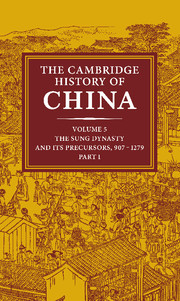Book contents
- Frontmatter
- Introduction: the Sung Dynasty and Its Precursors, 907–1279
- 1 The Five Dynasties
- 2 The Southern Kingdoms between the T’ang and the Sung, 907–979
- 3 Founding and Consolidation of the Sung Dynasty under T’ai-tsu (960–976), T’ai-tsung (976–997), and Chen-tsung (997–1022)
- 4 The Reigns of Jen-tsung (1022–1063) and Ying-tsung (1063–1067)
- 5 Shen-tsung’s Reign and the New Policies of Wang An-shih, 1067–1085
- 6 Che-tsung’s Reign (1085–1100) and the Age of Faction
- 7 The Reigns of Hui-tsung (1100–1126) and Ch’in-tsung (1126–1127) and the Fall of the Northern Sung
- 8 The Move to the South and the Reign of Kao-tsung (1127–1162)
- 9 The Reign of Hsiao-tsung (1162–1189)
- 10 The Reigns of Kuang-tsung (1189–1194) and Ning-tsung (1194–1224)
- 11 The Reign of Li-tsung (1224–1264)
- 12 The Reign of Tu-tsung (1264–1274) and His Successors to 1279
- Bibliography
- Glossary–Index
- References
10 - The Reigns of Kuang-tsung (1189–1194) and Ning-tsung (1194–1224)
Published online by Cambridge University Press: 28 March 2010
- Frontmatter
- Introduction: the Sung Dynasty and Its Precursors, 907–1279
- 1 The Five Dynasties
- 2 The Southern Kingdoms between the T’ang and the Sung, 907–979
- 3 Founding and Consolidation of the Sung Dynasty under T’ai-tsu (960–976), T’ai-tsung (976–997), and Chen-tsung (997–1022)
- 4 The Reigns of Jen-tsung (1022–1063) and Ying-tsung (1063–1067)
- 5 Shen-tsung’s Reign and the New Policies of Wang An-shih, 1067–1085
- 6 Che-tsung’s Reign (1085–1100) and the Age of Faction
- 7 The Reigns of Hui-tsung (1100–1126) and Ch’in-tsung (1126–1127) and the Fall of the Northern Sung
- 8 The Move to the South and the Reign of Kao-tsung (1127–1162)
- 9 The Reign of Hsiao-tsung (1162–1189)
- 10 The Reigns of Kuang-tsung (1189–1194) and Ning-tsung (1194–1224)
- 11 The Reign of Li-tsung (1224–1264)
- 12 The Reign of Tu-tsung (1264–1274) and His Successors to 1279
- Bibliography
- Glossary–Index
- References
Summary
Southern Sung prosperity struck turbulent waters in the late twelfth century. During his twenty-six-year reign, Hsiao-tsung (r. 1162–89) was a conscientious and strong ruler, yet when his adopted father, the retired emperor Kao-tsung, died in 1187, Hsiao-tsung had a very difficult time coping with the loss. Although suspending court was normal under the circumstances, when Hsiao-tsung did not resume audiences for over a month, pressure on him from officials mounted. Hsiao-tsung returned, but reportedly was able to walk only with the aid of a cane, a sign of his physical and emotional frailty. Once the epitome of political activism, Hsiao-tsung now turned to the heir apparent to assist him in managing state affairs.
The heir, Chao Tun (1147–1200), found himself cast in the role of auxiliary emperor. Chief ministers were instructed to consult Chao Tun every two days, and his presence was expected at court audiences. This arrangement troubled officials from the outset. Reader-in-waiting Yang Wan-li (1127–1206) took the arrangement to imply the existence of two rulers and warned of potential instability. Ignoring the warning, Hsiao-tsung spurned Chao Tun’s own offer to take a diminished role at court. Hsiao-tsung also insisted on performing to their fullest mourning rites for Kao-tsung. Most previous Sung emperors had accepted a less rigorous mourning regime, and officials proposed as much for Hsiao-tsung. The emperor would hear nothing of it, and ordered audiences to be held in the inner palace. Hsiao-tsung never seemed to appreciate the officials’ dilemma of seeking to serve two political authorities without the certainty as to which authority was more important, the seated emperor or the already influential heir apparent.
- Type
- Chapter
- Information
- The Cambridge History of China , pp. 756 - 838Publisher: Cambridge University PressPrint publication year: 2009
References
- 2
- Cited by



